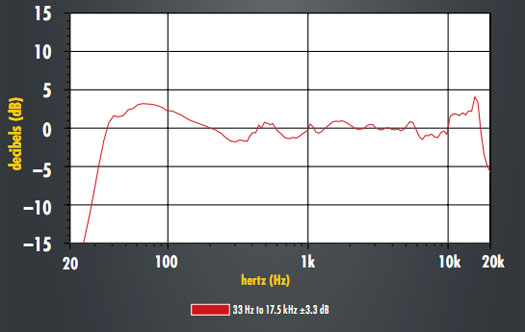Test Report: Axiom Audio M60 v3 Tower Speakers Page 4

Frequency response (at 2 meters): 33 Hz to 17.5 kHz ±3.3 dB
Sensitivity (SPL at 1 meter with 2.8 volts of pink-noise input): 90 dB
Impedance (minimum/nominal): 5.0/9 ohms
Bass output (CEA-2010 standard)
Ultra-low bass (20-31.5 Hz): N/A
Low bass (40-63 Hz): 87.6 dB
The frequency-response curves shown in the graph are weighted to reflect how sound arrives at a listener's ears with normal speaker placement. Because the M60 v3 is a left/right front speaker, we use an average of curves taken across a horizontal listening window of ±30 degrees, smoothed to 1/12th octave. Measurements were made at 2 meters to ensure that full effects of cabinet diffraction and front-panel reflections were included. Measurements were made with the grilles off because I suspect that's how most people will use them, but I also ran sweeps with the grilles on to gauge their effect on the sound. The M60 v3 tower was measured standing on the ground, which is the way it will always be used. These tests gave quasi-anechoic results down to about 250 Hz. Response of woofers and ports was close-miked, summed, and spliced to the quasi-anechoic response.
As one expects of Canadian-school speakers, the M60 v3 measures beautifully, with generally flat response overall and practically dead-flat response from 400 Hz to 10 kHz - a region that encompasses most of the midrange and all but the top octave of treble. There's a very mild bump at 500 Hz that may be the result of floor bounce, and a strong +4-dB peak at 15.5 kHz. Off-axis response is very good; except for the expected treble rolloff, the sound barely changes as you move off-axis. Adding the grilles makes almost no difference - except for a dip of about 2 dB between 6 and 10 kHz, the response with or without the grilles is essentially identical.
The M60 v3 couldn't be much easier to drive. Sensitivity is very good at 90 dB, while impedance averages 9 ohms and drops to a minimum of 5.0 ohms at 44 Hz. The impedance phase shift is so mild that it's not worth detailing. You could probably wire this thing straight up to a pocket radio if you wanted to.
Since the M60 v3 is billed as a more-or-less full-range speaker, I measured its bass output in the same way I measure subwoofers, using the CEA-2010 standard. Average low bass (40-63 Hz) output is 87.6 dB and average ultra-low bass (20-31.5 Hz) output is unmeasurable - although I did get a little bit of output (67.9 dB) at 31.5 Hz. So the M60 v3 is no bass monster, but it has enough low end to make a subwoofer optional instead of required. Incidentally, the vortex port design seems to work - I didn't hear any port noise during my bass tests.
-Brent Butterworth













































